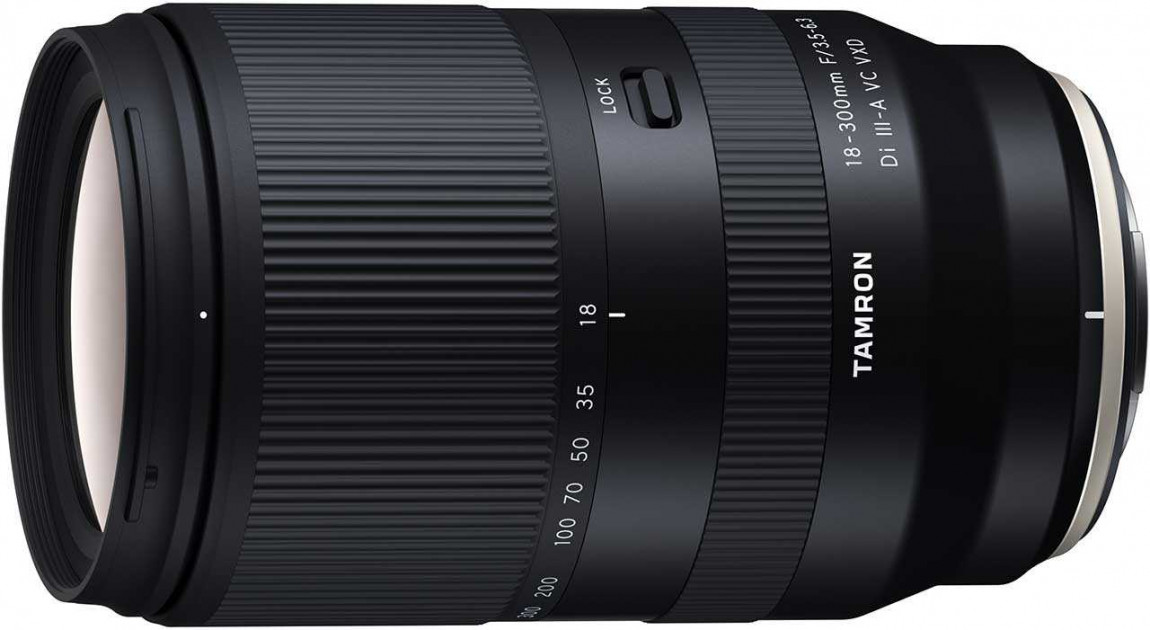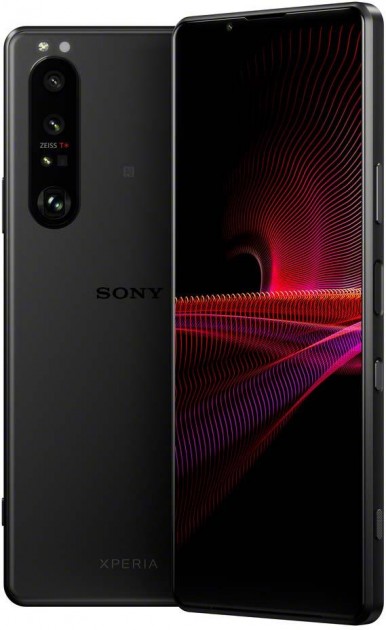Introduction
Almost three years ago, I attended a Zeiss press conference at the Photokina 2018 photography show in Cologne, Germany.
Held offsite at a trendy warehouse with no wi-fi and no food, the gathered journalists entered the auditorium to a chorus of cheering and a series of high-fives from what seemed like hundreds of Zeiss employees, accompanied by jets of dry-ice.
The usually 100% reliable camera rumour-mill had been eerily quiet about what Zeiss had up their sleeves. I’d presumed it would be another high-end lens series from a company that was well-know for making impeccably constructed, optically excellent lenses with price-tags to match.
And they did launch a high-end lens series, unveiling four Batis branded lenses for mirrorless cameras. But little did I know that Zeiss were also about to launch a full-frame mirrorless camera, the ZX1, and not only that, a camera with Adobe Lightroom built-into it, right on the device itself.
Fast forward three years, and the world is a somewhat different place. Despite promising that it would launch in 2019, the Zeiss ZX1 became vapourware for two years before re-surfacing in October 2020 with a limited launch in the United States and Germany.
Now in mid-2021 the ZX1 has also made it way to Europe and the UK, and I’ve been able to get hold of one from Zeiss UK for review.
So what’s so exciting about the Zeiss ZX1, and is it still as relevant today as it promised to be in 2018?
This is a 37.4 megapixel 35mm full-frame mirrorless camera with a newly developed 35mm f/2 prime lens that has no distortion even what shooting in RAW.
It has a built-in OLED electronic viewfinder and a massive 4.3 inch, HD (1280 x 720), 338ppi resolution touchscreen LCD display on the back, which as we’ll come onto is at the very heart of the ZX1.
There are no memory card slots at all – instead the ZX1 has 512Gb SSD internal memory or you can upload your images to a Cloud service for storage.
Lightroom Mobile CC is integrated into the ZX1, powered by the onboard Android operating system and providing onboard RAW editing via Adobe for the very first time on any camera.
You can also instantly share your photos on services like Flickr, OneDrive and Dropbox and also automatically update the firmware.
There’s also built-in Wi-Fi with NFC and Bluetooth connectivity, a USB Type-C port, UHD 4K/30p video recording, a leaf shutter for silent shooting, contrast and phase-detection AF system
It even looks pretty unusual, sporting a slight bend to its aluminium body on the right-hand side for better ergonomics.
Explaining the delay in releasing the ZX1, Jörg Schmitz, Head of ZEISS Consumer Products, commented “We have once again worked intensively on the overall workflow and the smooth integration of hardware and software and are convinced that it was worth the wait”.
With a price-tag of £5399 / $6000, the Zeiss ZX1 is clearly something of a considered purchase it is fixed 35mm lens, unconventional design and all-encompassing “Shoot, Edit, Share” ethos, so let’s take a closer look and find out if it can live up to its promise.
Ease of Use
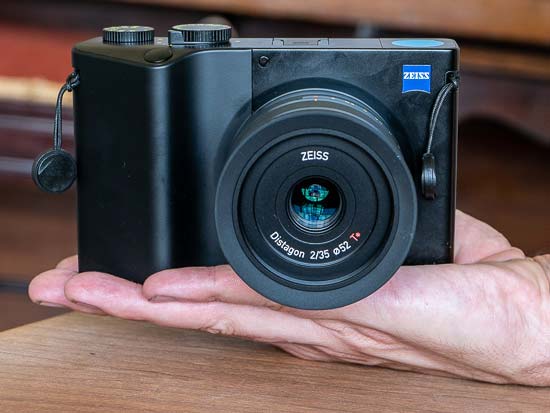 |
By pairing a 35mm full-frame sensor with a 35mm fixed prime lens, the Zeiss ZX1 is clearly something of a niche camera from the outset.
Up against the likes of the Leica Q2, Fujifilm X100V, Ricoh GR III and the five-year-old Sony RX1R II, the ZX1 joins an exclusive band of cameras that all take a markedly different approach.
The Zeiss ZX1 is by far the largest and heaviest, measuring 142 x 93 x 94mm and weighing in at 837g with the battery installed.
It’s an impeccably made device that, dare we say it, even surpasses the high build-quality standards that Leica are famously known for.
In-hand, the ZX1 feels incredibly sturdy and more than ready to withstand whatever you might throw at it, with no flex at all apparent in its all-aluminium body.
Somewhat surprisingly, though, there is no weather-sealing at all on this camera, so despite its aura of invincibility, its probably best not to use it outside in inclement conditions without protecting it in some way.
All of the various dials and buttons are well-machined and offer just the right amount of tactile movement, from the spring loaded power switch to the shutter speed and ISO speed dials, to the shutter release button and the aperture ring on the lens.
It’s clear that Zeiss have paid an awful lot of attention to getting everything just right on the ZX1 from a quality point of view.
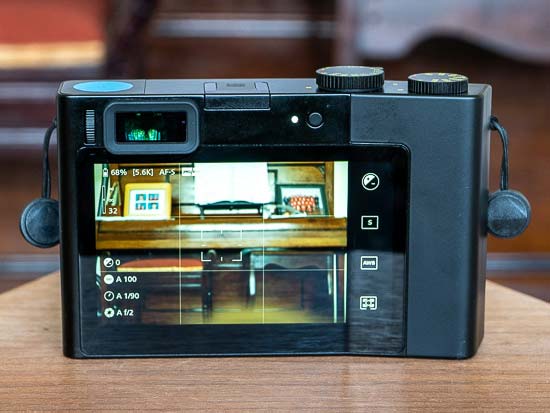 |
What’s perhaps less clear, for some users at least, is the pared-back nature of the ZX1’s overall design.
There are just seven external controls in total on the entire camera. On the lens there’s a manual focus ring and an aperture ring that runs from f/2 to f/22 in 1/3-stop increments with an Auto setting, plus an AF/MF focus mode switch.
While the f/2 lens is optically excellent (take a look at the Image Quality section), there are a few drawbacks to its design from a usability point of view, which are especially apparent when using the viewfinder.
Firstly, the aperture ring is very narrow making it hard to locate in a hurry, and it’s also finished in the same rubber coating as the MF ring, causing a few mix-ups along the way. It could really have benefited from a different, possibly textured surface to help differentiate it.
The Auto setting is at the start of the aperture range before f/2, rather than at the end after f/22, which seems a little illogical to us, while the manual focus ring isn’t particularly well damped. Perhaps all individually fairly minor things, but collectively they make the lens less usable that it could have been.
On a more positive note, the ZX1’s lens has an in-built leaf shutter which allows for synchronization with external flashes at shutter speeds of up to 1/1000th sec, as well as providing virtually silent shooting that’s perfect for street photography.
As a direct consequence the mechanical shutter speed is also limited to 1/1000th sec, and although the ZX1 also has an electronic shutter, that only goes up to 1/2000th sec, all of which can prove problematic in very bright conditions if you don’t have an ND filter to hand.
On top is the shutter release button, ISO speed dial, shutter speed dial and a three-part On/Off/Sleep switch (more on this shortly), plus an external flash hotshoe which is compatible with the Sigma TTL flash protocol.
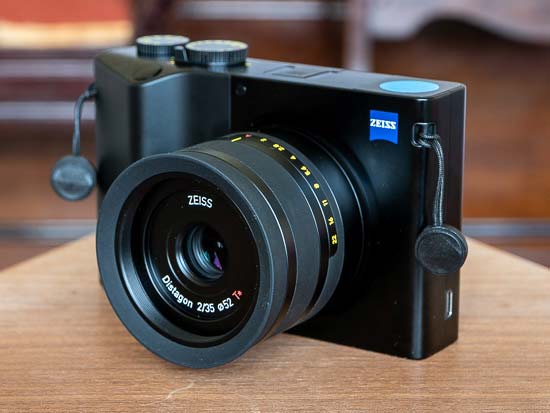 |
In addition to the EVF with dioptre control and massive LCD screen, on the rear there’s a solitary unmarked Function button that by default enables AE-L (it can be reconfigured to AE-L/AF-L, AF-L or nothing at all).
On the side there’s an unprotected USB-C port, and on the bottom a tripod mount that’s inline with the lens mount, and finally the battery compartment.
And that’s it. Clearly if you like your camera to have a plethora of external controls, the ZX1 isn’t going to be well-suited to you, such is the extent to which Zeiss have pared back the external design and focused instead on making everything controllable via the LCD touchscreen.
The ZX1 has a huge 4.34-inch screen, that largest that we’ve seen on any camera that we’ve ever reviewed before (and we’ve reviewed literally hundreds of cameras in the last 17 years).
What’s more, the screen has been very cleverly integrated into the overall shape of the camera, specifically the design of the handgrip.
As well as having a slight bulge at the front, approximately a third of the right-hand side of the ZX1 is then angled backwards to provide a large, if completely smooth, handgrip that’s large enough to accommodate all four fingers of your right hand.
Despite the untextured surface, it feels surprisingly secure, presumably due to the ergonomic backwards sweep and the sheer size of the surface area that Zeiss have made available.
That’s not all though – if you look carefully at the rear of the camera, you’ll notice that the right-hand side of the LCD screen is also angled backwards to match the handgrip.
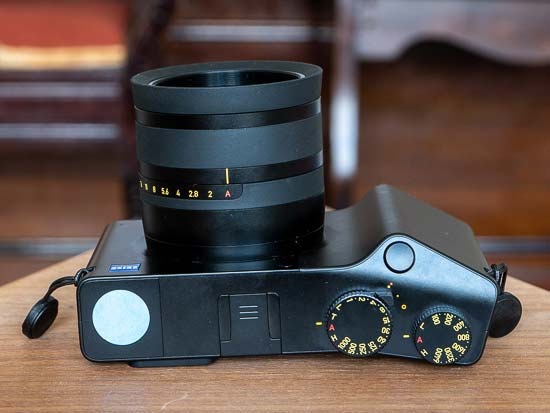 |
I’m not quite sure how they’ve done it, but the LCD screen on the ZX1 is not completely flat across its width – about 2cm of it changes angle.
Zeiss have done this for a good reason, rather that just trying to show-off. When you turn the camera on, a vertical column of icons logically occupies that 2cm space, with the “main” part of the screen reserved for the usual image composition and playback.
It’s a very clever piece of industrial design that subtly separates the camera’s menu system from the rest of the user interface.
There are 10 right-hand icons in total, providing access to exposure compensation, drive mode, white balance, metering, AF EVF mode, AF area type, AF mode, AF size, collections (where you want to store your photos) and helpers (essentially extra display options).
Essentially the right-hand vertical icons act as a sort of quick menu system with all of the camera’s principal controls in it, through which you can scroll up and down very naturally with your right-hand thumb.
By default the main LCD screen displays certain key information over on the left-hand side – battery life, AF mode, image quality setting, and the current exposure compensation, ISO speed, shutter speed and aperture settings.
There are five additional display items available in the Helpers menu – level indicator, histogram, grid, clipping, depth of field – with the optional ability to hide most of them with a half-press of the shutter button.
Overall it’s a pretty clearly thought-out system, with the combination of the physical controls on the lens and top of the camera working well with the onscreen, “soft” controls on the touchscreen.
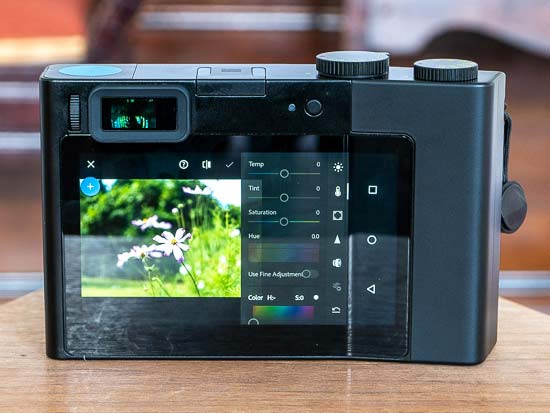 |
One area where it perhaps falls down a little if auto-focusing, or rather quick auto-focusing. We’re so used now to having an AF joystick available on almost every mid-to-high-end camera that not having one on the ZX1 and instead having to use the touchscreen to move the AF point feels like something of a retrograde step, even though Zeiss have provided a clever way of moving the AF button when using the EVF.
It’s not apparent when you first start to use the camera exactly how to access the camera’s main menu system or how to playback images. There are no physical buttons or onscreen icons to guide you. Instead, you simply swipe down from the top of the screen to playback images, and swipe up from the bottom of the screen to open the main menu settings. A quick double-swipe down goes straight to the Android Home screen which includes the Lightroom Mobile app, so you can start using it without the need to open an image and choose the Edit option.
On our test sample there were six options on the Home screen – Manual, Support and Tutorial, plus Lightroom and Instagram. It’s not clear at this point which, if any, additional apps can be installed on the ZX1. A half-press of the shutter button takes you back into the camera.
I did find that in certain lighting conditions, though, the camera was less than responsive, in that it often required several swipes rather than one to open the desired menu – indoors was much more reliable than out – which proved to be incredibly frustrating at times, slowing down the operation of the camera.
Overall, the ZX1’s touchscreen interface is a veritable joy to use. Powered by Android, it’s as responsive as any modern smartphone when it comes to responding to user inputs and providing sound and haptic feedback, apart from the lighting niggles aside. It certainly puts most other cameras that we’ve tested in the metaphorical shade.
Running on the Android OS is also the driver behind why the ZX1 has a three-part, On/Off/Sleep switch. When you start it from completely Off, the camera takes around 10 seconds to boot-up, much like the majority of smartphones.
Obviously this delay isn’t particularly desirable for a a device that’s supposed to be ready for the decisive moment, so Zeiss have added to a third setting on the power switch which puts it to sleep, rather than fully off. It then takes less than a second to come back to life.
So you’ll want to turn off the camera fully when not using it for an extended period of time to conserve bater life, but always use the Sleep mode when shooting to enable the camera to almost instantly wake up, ready for action.
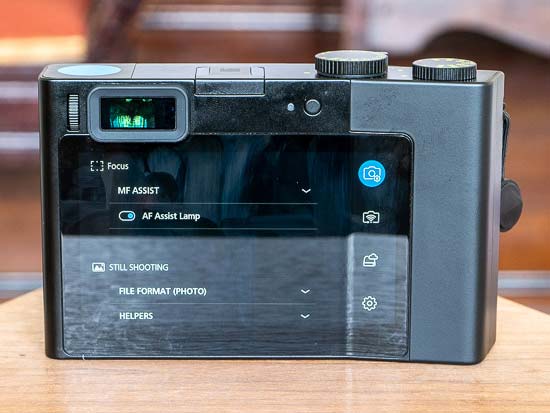 |
This being Zeiss, the Power switch rather cleverly has a fourth function. When you turn the camera on, it automatically starts in still photo mode. If you want to switch to video recording mode, simply push up on the power switch to toggle between stills and movies.
Again, it’s not readily apparent when you first use the ZX1 how to switch between the two modes, but the way in which Zeiss have implemented it is very clever indeed.
Completing the ZX1’s principal controls is the excellent 0.7-inch electronic viewfinder – although not quite class-leading any more (it might have been in 2018, but this is 2021), the 0.74x magnification electronic viewfinder with 6.22M dots is fantastic to use.
Cleverly you can operate the right-hand set of icons from the LCD screen when looking through the viewfinder – they’re replicated on the right-hand side of the EVF, and as you use the touchscreen to select them with your right thumb, each one if highlighted in the EVF.
There’s a similar idea for choosing the AF point, with a rectangular box on the LD screen replicated in the EVF showing where the point is, although it’s less precise and we’d still have preferred an AF joystick.
The AF system itself is either refreshingly pared-down or rather basic, depending on your view-point – we’d go for the latter. The spec sheet lists it as being both contrast-detection AF and phase-detection AF, which may well be true, but in practice there’s still a noticeable delay when locking on to the subject – it’s reliable, but slightly laggy.
There are two AF modes, Single AF and Continuous AF, with no subject-tracking option, so although you can move the AF point around using the touchscreen, using Single AF mode and then recomposing is probably the quickest method to get the preferred composition, although really only suitable for still or slow-moving subjects.
Face Detection is supported, but the camera has a tendency to constantly re-focus until it has found a face, even when you’re half-pressing the shutter button. When it does focus on a face, the AF box disappears and the face is outlined, but the camera always tries to maintain and possibly re-focus on that face whether you’re half-pressing the shutter button or not. It’s not the most sophisticated or reliable system in 2021.
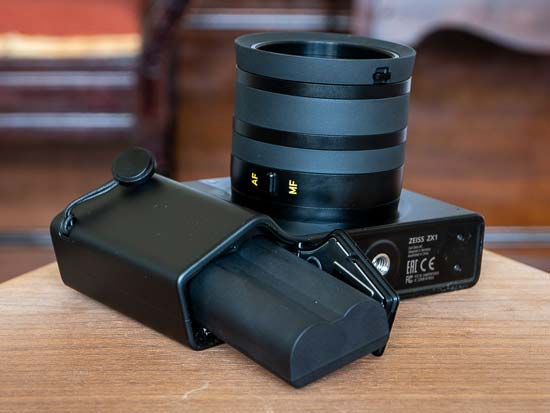 |
Although commendably large and of high resolution, the EVF is somewhat hampered by having a really shallow eyecup that forces you to press your eye against it to get the full view, which isn’t great for glasses wearers.
The ZX1 has a USB-C connector on its left-hand flank that supports the latest USB 3.2 speeds. It can be used for charging the camera from a powerbank when out and about, transferring files to your computer or to an external SSD, or adapting to an HDMI output signal.
As noted above, though, it is completely unprotected, a rather incongruous decision in an otherwise incredibly well-thought design.
The lack of dual memory cards has been a criticism of many a recent camera launch, but how about no memory cards at all?!
Yes, that’s right, the ZX1 has dispensed with those old fashioned things in favour of a built-in SSD, which offers 512GB of storage, enough for more than 7,000 RAW files.
Whilst we commend Zeiss for thinking out of the box, their approach to physical storage does have a few drawbacks.
Firstly, the SSD is more fast enough to keep up with the ZX1’s fastest shooting speeds, although the 3fps maximum burst rate is not going to be overly taxing many cameras. The main operational issue is heat – after the camera has been turned on a for a short while, the bottom of the camera is noticeably warm – not hot as such, but warm enough to make you take heed.
With the ability to store so many photos on the device and also optionally save them to a cloud service, the ZX1 has a lot of bases covered, but the time-proven option of being able to take out a card and quickly transfer your photos onto a computer is still rather sorely missed.
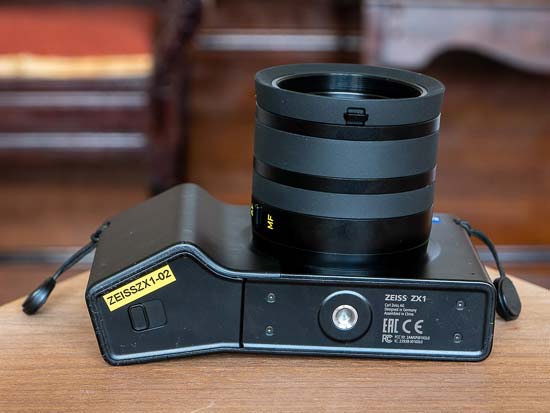 |
Thirdly, there’s obviously a question mark over the life-span of the SSD and what the failure rate is – Zeiss haven’t published any technical data about who makes it or what its specifications are.
Finally, when you do want to transfer files from the SSD onto an external device, the transfer rate isn’t particularly fast, not helped by the 78Mb RAW files that the ZX1 creates.
So while being able to store all of your photos on the ZX1 sounds great in theory, we really wish that Zeiss had at least added one memory card slot too, at least to offer some flexibility.
With no memory cards required, there’s just the battery compartment on the bottom of the camera which houses a 3190 mAh 22.9 Wh Li-ion battery pack. Zeiss don’t publish any CIPA data for battery life, possibly because running Android OS and turning the device on, off and into standby somewhat skews the figures. If you remember to keep the device in Sleep mode, though, you can easily get through a day’s shooting without running the battery down completely.
The Zeiss ZX1 is much more stills-focused than video. Although it offers 4K/30p and 1080/60p shooting, somewhat inexplicably they are the only two quality/frame rate options available. By default 4K is recorded using an h.265 codec and Full HD is using an h.264 codec.
The most severe limitation for video is the 1.48x crop that’s applied for both 4K and 1080p, turning the ZX1’s moderately wide-angle 35mm lens into a 52mm equivalent, which is much less well-suited.
You can choose from the various manual and automatic shooting modes an use exposure compensation, plus control the levels of the camera’s stereo mics, but that’s pretty much all of the video options that are available.
Usually image playback and sharing options on cameras are something of an after-thought. You might be able to do basic editing, possibly of the RAW files, using the rather small 3-inch-ish readscreen, and then share some of them via Wi-fi or by pairing with your phone over Bluetooth. Traditionally, though, digital cameras have focused on taking the image, rather than editing or sharing it.
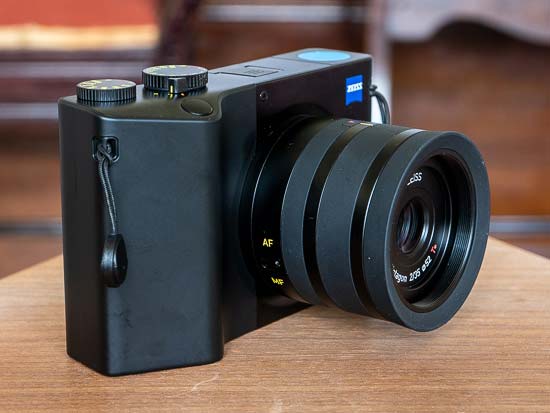 |
The Zeiss ZX1 attempts to turn that approach entirely on its head by including a full version of Adobe Lightroom Mobile on the actual device.
You can access it either by going into image playback and selecting the Edit option or by going to the Home screen and pressing the Lightroom icon.
Whereupon a fully-featured, fully-operational, Android version of Adobe Lightroom Mobile appears on the ZX1’s 4.34-inch screen in all its glory – v6.2.0 was installed on the review sample that Zeiss sent to us, which was released in June 2021, just one version behind the very latest 6.3.0 (as of writing).
Zeiss and Adobe give new ZX1 owners a 1-year Lightroom subscription with 1TB of cloud storage – after that you need to subscribe to get access to all of the premium features, although you can still use the ZX1 to do basic editing and adjustments even without a paid Adobe account.
Actually using Lightroom Mobile on the ZX1 is commendably just like using it on any other Android-based mobile device. The LCD screen may not be quite as large as on most modern smartphones, but it’s big enough to make editing a mostly pleasurable experience, although you’ll maybe want to use a larger monitor for longer sessions – that’s true of using Lightroom on any small mobile device though.
Where the ZX1 literally lags behind though is out-and-out speed – we don’t know what processor the ZX1 is using, but it certainly isn’t one from 2021 – it provides editing and exporting speeds that are more in line with a 2-year old smartphone like the Huawei P30 Pro that I personally use. Obviously as Lightroom evolves further and is expanded, running it on the ZX1 may become an even slower experience. It’s not especially bad, per se, just something to be aware of if you buy the ZX1 expecting it to provide a lightning-quick editing experience.
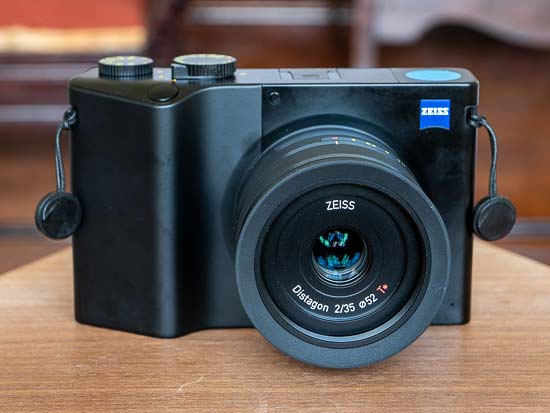 |
The other drawback is the ZX1’s complete reliance on Lightroom for editing your images – there are no other in-camera options available, no built-in profiles, colour modes or even basic editing functions. What is undoubtedly a major attraction for some users will undoubtedly be a major turn-off for others.
The last part of the ZX1’s round-trip jigsaw is sharing and backing-up your images.
There’s the now standard wi-fi and Bluetooth connectivity for sharing images via a smartphone, much like any other modern camera, but the ZX1 has a number of additional options too.
These include connecting directly to social media, although the only option currently available is Facebook, or to one of three different cloud storage services – Dropbox, Flickr and OneDrive. You can also connect to Instagram, but strangely only via the Home screen – it’s not included in the main menu system.
The ZX1 can also be connected to an FTPS Server or Network Attached Storage (NAS) device to both backup your files and remotely access the files that are on on your NAS drive.
Firmware updates for the ZX1 can be downloaded over-the-air and installed while on-the-go without any intervention required from the user.
The real icing on the cake would have been some form of celluar connectivity as well as wi-fi and Bluetooth, which really would have made the ZX1 a fully-connected powerhouse, but alas Zeiss have chosen to only support wi-fi and Bluetooth.
Image Quality
All of the sample images in this review were taken using the 37.4 megapixel JPEG image size option, which produces an average image size of around 6Mb.
The Zeiss ZX1 produced images of excellent quality during the review period. It offers noise-free images at ISO 80 through to 800, with limited noise starting to appear at ISO 1600. ISO 3200 and 6400 exhibit progressively more noise and loss of fine detail, while the fastest settings of 12800 to 51200 look much better on paper than in reality.
The night photograph was excellent, with the maximum shutter speed of 60 seconds allowing you to capture plenty of light.
Chromatic aberrations and distortion are well controlled, vignetting wide-open at f/2 is apparent but not excessive, the minimum focusing distance of 23cm comes in useful, and the lens is capable of creating some lovely bokeh effects.
Noise
There are 11 ISO settings available on the Zeiss ZX1 which you can select at any time using the ISO dial on top of the camera. Here are some 100% crops which show the noise levels for each ISO setting for both JPEG and RAW formats.
|
JPEG |
RAW |
|
ISO 80 (100% Crop) |
ISO 80 (100% Crop) |
 |
 |
|
ISO 100 (100% Crop) |
ISO 100 (100% Crop) |
 |
 |
|
ISO 200 (100% Crop) |
ISO 200 (100% Crop) |
 |
 |
|
ISO 400 (100% Crop) |
ISO 400 (100% Crop) |
 |
 |
|
ISO 800 (100% Crop) |
ISO 800 (100% Crop) |
 |
 |
|
ISO 1600 (100% Crop) |
ISO 1600 (100% Crop) |
 |
 |
|
ISO 3200 (100% Crop) |
ISO 3200 (100% Crop) |
 |
 |
|
ISO 6400 (100% Crop) |
ISO 6400 (100% Crop) |
 |
 |
|
ISO 12800 (100% Crop) |
ISO 12800 (100% Crop) |
 |
 |
|
ISO 25600 (100% Crop) |
ISO 25600 (100% Crop) |
 |
 |
|
ISO 51200 (100% Crop) |
ISO 51200 (100% Crop) |
 |
 |
Night
The Zeiss ZX1’s maximum shutter speed is 30 seconds which is set using the L option on the Shutter Speed dial.
The shot below was taken using a shutter speed of 30 seconds at ISO 80. The camera takes the same amount of time again to apply noise reduction, so for example at the 15 second setting the actual exposure takes 30 seconds.

Focal Range
The Zeiss ZX1’s focal length of 35mm provides an angle of view of 63.4 degrees.

Chromatic Aberrations
Chromatic aberrations, typically seen as blue or purple fringes along contrasty edges, were not very apparent in our test shots, only appearing in very high contrast areas.

Distortion
There’s virtually no barrel distortion evident in either the JPEG or RAW files.

Light Fall-off
With the lens set to its maximum aperture of f/2, there is some fairly obvious light fall-off in the corners, requiring you to stop down by at least 2 f-stops to prevent it.

Macro
The Zeiss ZX1’s 35mm lens offers a minimum focusing distance of 23cm.



Sunstars and Flare
The Zeiss ZX1 doesn’t create the nicest sunstars when stopped-down to f/22 or f/32, as shown below, although flare is at least fairly well controlled when shooting directly into the sun.


Bokeh
Bokeh is a word used for the out-of-focus areas of a photograph, and is usually described in qualitative terms, such as smooth / creamy / harsh etc.
In the ZX1, Zeiss have employed an iris diaphragm with 9 rounded blades, which has resulted in very nice bokeh in our view.
We do realise, however, that bokeh evaluation is subjective, so we’ve included lots of examples below for your perusal.






Sample Images
This is a selection of sample images from the Zeiss ZX1 camera, which were all taken using the 37.4 megapixel JPEG setting. The thumbnails below link to the full-sized versions, which have not been altered in any way.
Sample RAW Images
The Zeiss ZX1 enables users to capture RAW and JPEG format files. We’ve provided some Zeiss RAW (DNG) samples for you to download (thumbnail images shown below are not 100% representative).
Sample Movie & Video
This is a sample movie at the quality setting of 3840×2160 pixels at 30 frames per second. Please note that this 19 second movie is 96Mb in size.
Product Images






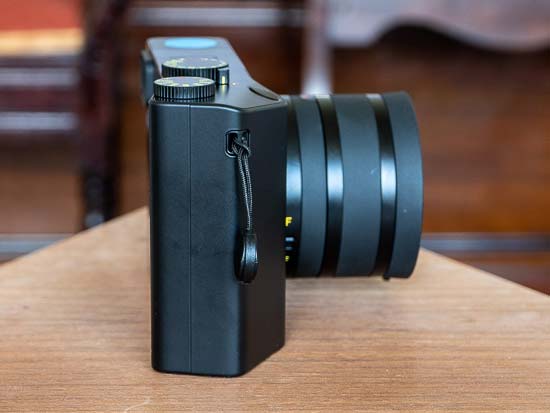
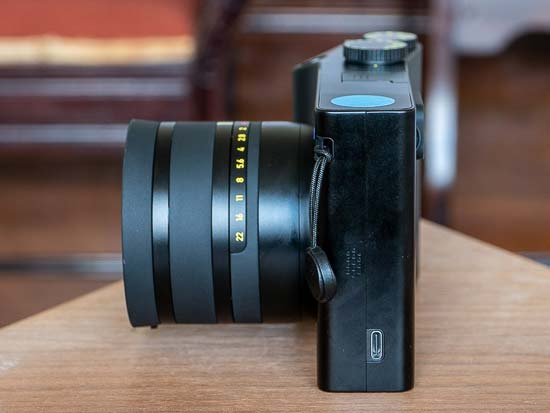



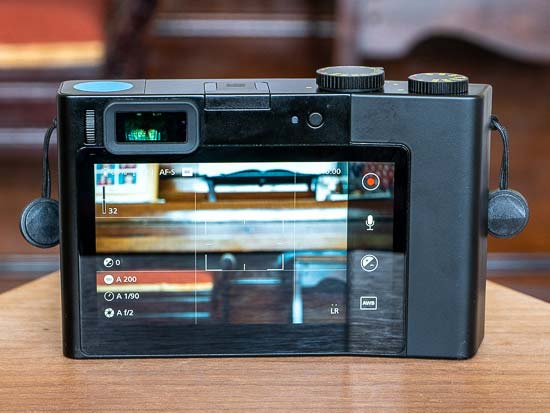
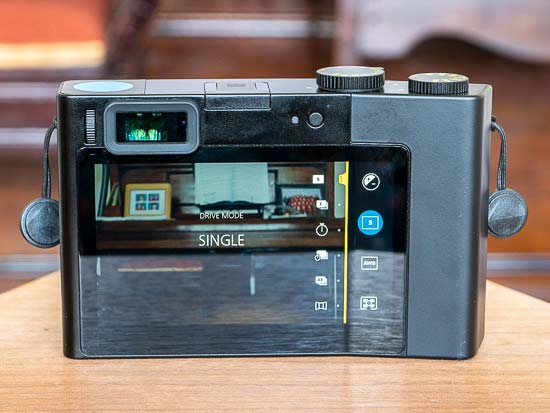

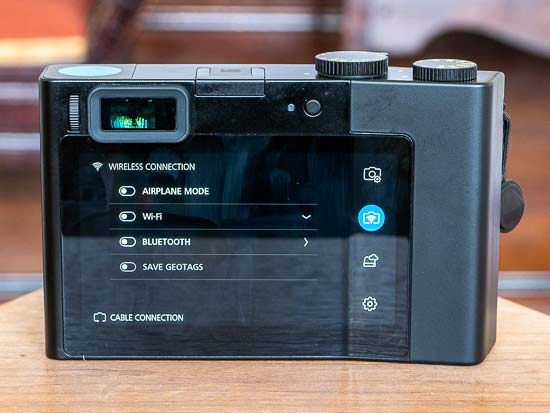
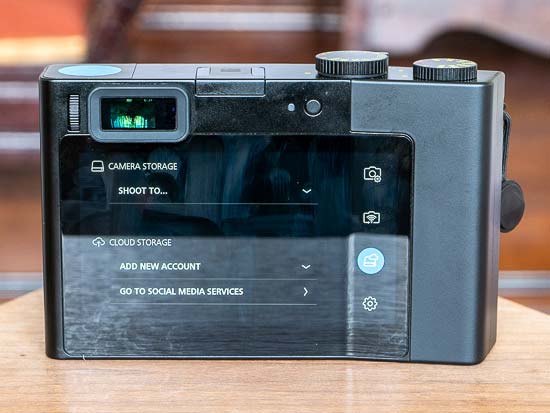
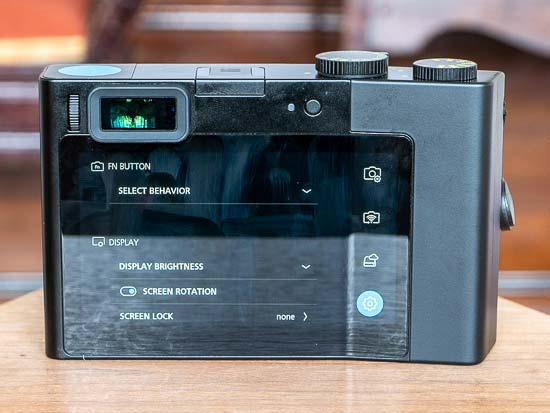
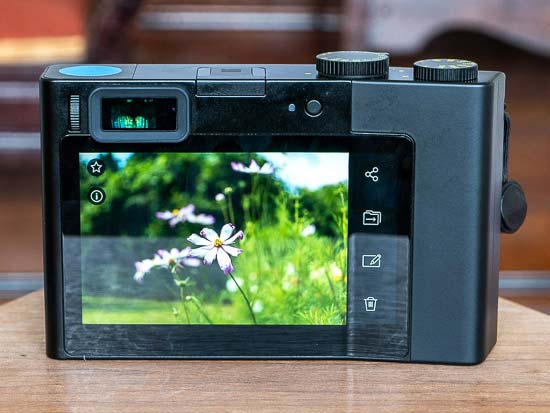
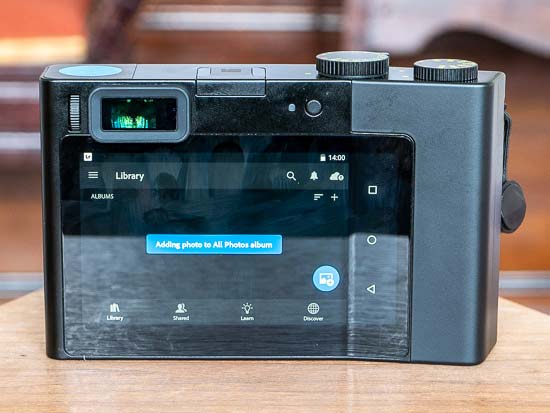
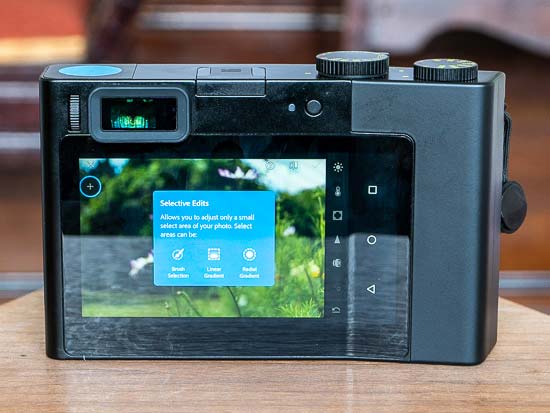

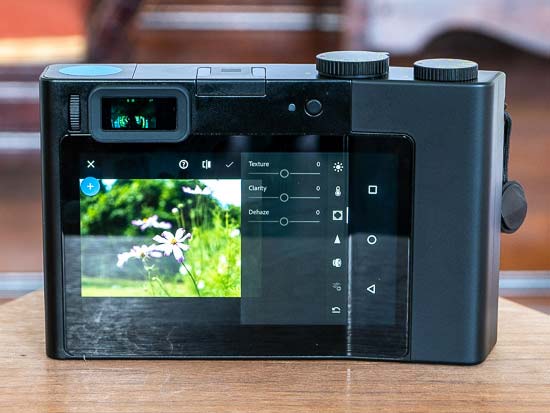

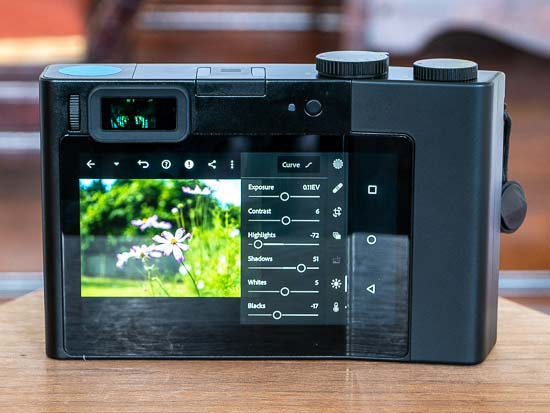
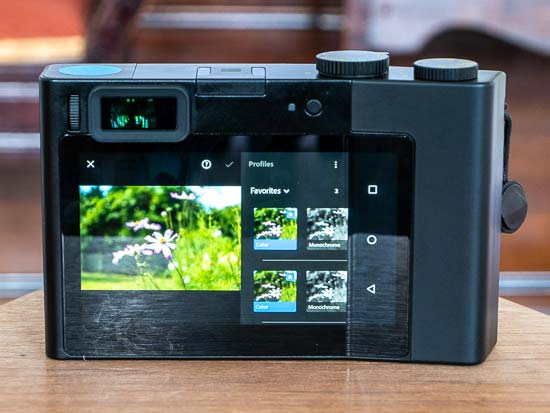
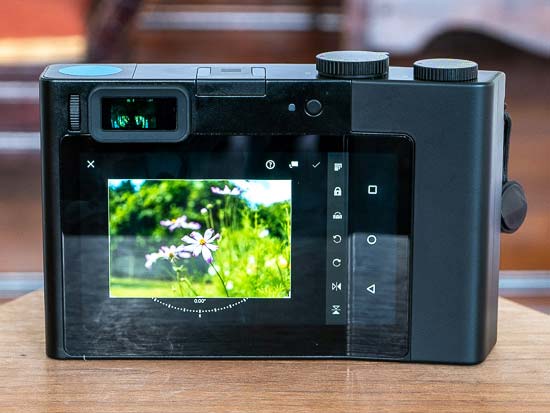
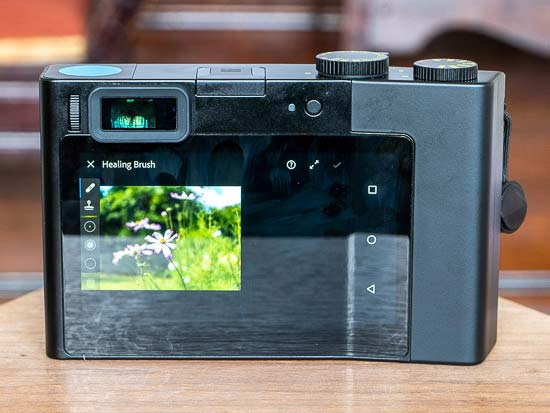
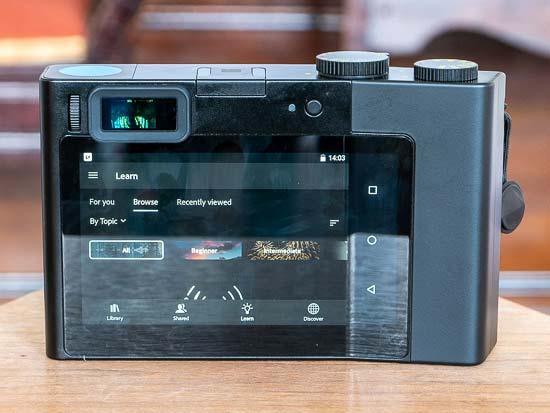
Conclusion
The Zeiss ZX1 was a unique, rather niche proposition when it was first unveiled at that glitzy Photokina press conference all those years ago, and now that it’s finally shipping to customers, it remains a unique and rather niche proposition that genuinely adds something new to the camera world, but falls a little short of Zeiss’ “Stay in your flow” marketing tagline.
Joining the small number of cameras with fixed prime lenses, the ZX1 certainly delivers the goods when it comes to its sensor and lens combination. The 37.4 megapixel sensor and 35mm f/2 lens are capable of creating stunning still photos that really will take your breath away.
Video, on the other hand, seems like more of an after-thought, with a heavy crop factor to contend with, just two different quality/frame rates and the marked absence of many of the advanced options that are commonly available on much cheaper mirrorless cameras.
Auto-focusing is also something of a mixed bag, proving to be fine for still or slower moving subjects but far less well-suited to any kind of action photography, not helped by the 3fps continuous shooting rate – this is a camera that suits both a more leisurely approach to shooting and more leisurely subject matter.
Zeiss have clearly thought out-of-the proverbial box when it comes to the design of the ZX1, and in large part they’ve succeeded in creating a camera that’s both genuinely different to the norm and genuinely better.
From the uniquely curved handgrip to the excellent EVF and massive LCD screen, to the incredible build quality and intuitive touchscreen interface, it’s clear that Zeiss have lavished a lot of attention and love on the ZX1.
Whilst the lack of external controls and greater reliance on the touchscreen will be off-putting for some, being able to shoot, store, edit and share photos from a single device is a pretty heady mix.
With a price-tag of £5400 / $6000, not too many photographers will actually get to experience the ZX1 for themselves, which is a real shame given that it at least offers an insight into what a modern camera can be.
Sure, you could buy a decent mirrorless camera, smartphone and laptop/tablet for the asking price of the ZX1, but that’s rather missing the point of the all-in-one approach that Zeiss have taken.
Overall, the Zeiss ZX1 is a high-end, very niche photography device that certainly isn’t going to save the camera industry or even sell in large numbers – but for a few lucky people, it could just be the camera that they’ve been waiting for…
| Ratings (out of 5) | |
|---|---|
| Design | 4.5 |
| Features | 5 |
| Ease-of-use | 4 |
| Image quality | 4.5 |
| Value for money | 3 |
Main Rivals
Listed below are some of the rivals of the Zeiss ZX1.
As its name suggests, the new X100V represents the fifth generation of Fujfilm’s now classic 35mm fixed lens premium compact camera series. The new Fuji X100V uses exactly the same 26 megapixel sensor and X-Processor 4 as the rest of the latest X-series cameras, and also adds weather-proofing, a revised lens design, tilting LCD touchscreen and 4K video recording into the rich mix. Read our in-depth Fujifilm X100V review now, complete with full-size sample images and videos…
The Leica Q2 is an exciting full-frame mirrorless compact camera with a 28mm fixed lens. The Q2 features a a new 47.3 megapixel sensor, 4K video mode recording at 30/24fps, high-resolution OLED viewfinder, dust and water resistance, and focusing speed of 0.15 seconds. Is this the ultimate compact camera? Find out now by reading our in-depth Leica Q2 review, complete with full-size sample photos and videos…
The new GR III is a significant update of Ricoh’s popular GR premium compact camera series, offering a 28mm fixed focal length lens, 3-axis image stabilisation system, large 24 megapixel APS-C sensor, 1080/60p video recording, 3 inch LCD touchscreen, flash hotshoe, and built-in wifi and bluetooth connectivity. Read our in-depth Ricoh GR III review complete with full-size JPEG and RAW sample images to find out if this camera still has what it takes in 2019…
The Sony RX1R II is a premium compact camera with a 42.4-megapixel full-frame sensor, variable optical low-pass filter, a Zeiss Sonnar T* 35mm f/2 lens and a built-in electronic viewfinder for eye-level shooting. Read our expert Sony Cyber-shot DSC-RX1R II review to find out if it’s worth the £2599 / $3299 asking price…
Review Roundup
Reviews of the Zeiss ZX1 from around the web.
The Zeiss ZX1 is the first-ever digital camera to come with Adobe Lightroom Mobile built-in, encouraging you to shoot, edit and upload images from a single device. It has a 37.4MP full-frame sensor, a fixed 35mm F2 lens and the largest screen we’ve ever seen on a modern digital camera at 4.34″ (11cm) diagonal.
Read the full review »
Specifications
| Dimensions (W x H x D) |
142 x 93 x 94 mm (5.59 x 3.66 x 3.70″) |
|---|---|
| Weight |
837 g (12.68 oz) (with battery) |
| Lens |
ZEISS Distagon T* 35mm f/2 |
| Sensor |
CMOS sensor, 24 x 36 mm, 39.5 MP total / 37.4 MP effective |
| Aperture range |
f/2 – f/22 in 1/3 EV increments, automatic |
| ISO range |
ISO 80 – 51200 in 1/3 EV increments; automatic |
| Shutter speeds |
1/2000 – 30s in 1/2EV increments, automatic, mechanical leaf shutter use limited to 1/1000 s or longer, flash synchronization up to 1/1000 s |
| Display |
4.3″ TFT LCD, 1280 x 720 px, 338 ppi, capacitive multi-touch enabled, scratch resistant cover glass with anti-fingerprint coating |
| Electronic viewfinder (EVF) |
0.7″ OLED, 1920 x 1080 px, magnification 0.74x with diopter adjustment and proximity sensor |
| Diopter range |
±3 dpt |
| Autofocus method |
Contrast-detection AF, phase-detection AF |
| Focus modes |
AF-S (MF override possible), AF-C, manual focus with magnification & peaking assist |
| Focus metering modes |
Single point (touch-enabled), touch & release |
| Exposure modes |
Automatic, aperture priority, shutter speed priority, manual exposure |
| Exposure compensation |
±3 EV in 1/3 increments |
| Exposure metering modes |
Multi, center, spot (fixed) |
| Exposure bracketing |
3 or 5 photos, from 1/3 to 2 EV increments |
| White balance modes |
Automatic, shade, cloudy, daylight, white fluorescent, tungsten light, manual WB metering, color temperature |
| Drive modes |
Single, continuous, self-timer (2, 10 or 20 s), interval, AE bracketing, panorama |
| Digital live view helpers |
Level indicator, histogram, grid, depth of field |
| Image format / resolution |
RAW (DNG) / JPEG: 7488 x 4992 px |
| Video format / quality |
MP4 video, 4K (3840 x 2160 px) up to 30fps withH.265, FHD (1920 x 1080 px) up to 60 fps withH.264, AAC audio codec |
| Audio |
Built-in microphone (stereo) and speaker (mono) |
| Flash |
Sigma SA-TTL-compliant flash hotshoe |
| Memory storage |
512 GB SSD (built-in), External storage via USB-C, NAS access using SMB protocol |
| Tripod thread |
DIN 4503 1/4-20 UNC |
| Connectivity (wired) |
USB 3.1 Gen 1, Type-C connector with USB-PD (Power Delivery), HDMI Alt Mode for USB Type-C supported |
| Connectivity (wireless) |
Wi-Fi 802.11b/g/n/ac, 2.4 / 5.0 GHz, Bluetooth 4.2 |
| Editing software |
Adobe Photoshop Lightroom preinstalled |
| Social media |
Yes |
| Cloud storage |
Yes |
| Firmware update |
Yes, firmware over-the-air via Wi-Fi |
| Battery |
3190 mAh 22.9 Wh Li-ion battery pack DDPS1A/DD-PS1E, exchangeable |
| Power supply |
AC adapter EA1045SJR, input 100-240 VAC, 50-60Hz, output 5V/3A, 9V/3A, 15V/3A, or 20V/2.25A |
| Sales package content |
Camera, lens ring, lens shade, lens cap, hotshoe cover, battery, AC charger, USB-C cable with adapter, carrying strap & strap accessories |
| Focal length |
35 mm |
| Aperture range |
f/2 – f/22 |
| Focusing range |
0.30 m (0.98 ft) – ∞ |
| Free working distance |
0.23 m (0.75 ft) – ∞ |
| Filter thread |
M52 |
| Autofocus |
Yes |
| Rotation angle of focus ring(∞ – MOD) |
Focusing not mechanically coupled. Rotation angle dependent on rotation speed. |
| Diameter max. (with lens shade) |
75 mm (2.95″) |
| Diameter of focus ring |
66 mm (2.60″) |
News
I’ve just arrived at the last press event at Photokina 2018. What have Carl Zeiss got up their sleeves? New lenses? A new camera?! Let’s find out…
More than 300 people are attending “a very special occasion” – press, photographers, dealers and distributors.
Zeiss are truly committed to photography, and to their distributors. So first announcement of the evening – the Zeiss Distributor Award of the Year 2018! And the winner is…LStream from Russia!
Some really exciting new about Batis is coming…
There are four current Batis lenses in the range, two wide-angle and two telephoto, but there’s something missing in the middle.
So Zeiss have officially announced the much-rumoured Batis 40mm f/2 CF lens for Sony Alpha cameras, which uses a Distagon optical design. The lens has a shortest shooting distance of 24cm, focus limiter switch, 67mm filter diameter, and 1:3.3 magnification.
The big announcement of the night, though, is the…wait for it…
Zeiss are launching an exiting new device that combines the image quality of a Zeiss lens with a smartphone. Shoot. Edit. Share. All on the same device.
Introducing the Zeiss ZX1. A 35mm, 37.4 megapixel full-frame mirrorless camera with a superb quality, newly developed 35mm f/2 lens that has no distortion even what shooting in RAW. The sensor is made by Zeiss in Germany. There’s an EVF, a massive 4.3 inch touchscreen display, intuitive user interace, 512Gb SSD internal memory, and a slight bend to the aluminium body on the right-hand side for better ergonomics.
Zeiss are the first manufacturer to integrate Lightroom Mobile CC directly into a camera for ease of editing. That’s right – onboard RAW editing via Adobe!
Sharing is the third element that Zeiss are addressing. You can instantly share on services like Flickr and Dropbox and update firmware over the air, so the camera is always up to date.
The Zeiss ZX1 will be available in early 2019. Price to be announced.
And that’s a wrap. Time for the hands-on experience…
Zeiss Press Release
ZEISS ZX1: The Camera Concept for the Creative Flow in Photography
First full-frame camera from ZEISS with first-class image quality and the familiar, intuitive image editing and connectivity of a smartphone.
ZEISS ZX1 – That is the name of the newly developed mirrorless full-frame camera from ZEISS that was presented today in Cologne, Germany. Thanks to the ZEISS lens and a sensor developed in-house at ZEISS, the camera delivers first-class image quality combined with an operational concept and user experience that make the photographer’s jobs-to-be-done as intuitive as on a smartphone.
The ZEISS camera concept is just the first step to opening up a new world of possibilities for ambitious photographers – from taking the shot to editing the image and sharing it on the web.
SHOOT. EDIT. SHARE. – Harmonized hardware, software and optics for a seamless creative process
SHOOT: the ZEISS ZX1 features a newly designed, integrated ZEISS Distagon 35 mm f/2 T* lens with autofocus that has been perfectly matched to the 37.4 megapixel full-frame sensor developed in-house at ZEISS. The interplay between the lens and sensor ensures first-class picture quality with that typical ZEISS look.
EDIT: The ZEISS ZX1 enables photographers to professionally process RAW images directly on the camera thanks to fully integrated Adobe Photoshop Lightroom CC. Moreover, the ZEISS ZX1’s unique user interface supports the user’s particular workflow without any interruption – providing direct access to the most frequently used functions via a 4.3″ multi-touch display.
SHARE: when the networked full-frame camera is connected, the user can upload selected images directly to the internet – without the intermediate transfer to memory cards or other external devices.
512 GB of internal memory provide sufficient space for approximately 6,800 RAW files (DNG) or over 50,000 JPGs – more than enough to handle photos, even during a longer trip, and giving the photographer the chance to let their creativity flow. Versatile connectivity options such as Wi-Fi, Bluetooth and USB-C ensure that various peripherals can be connected. Over-the-air software updates keep the camera up to date without requiring a computer connection.
Designed with a passion for detail and a focus on the essentials
The design of the ZEISS ZX1 is characterized by its iconic shape with carefully crafted details. The overall form and reduction to just those elements that are absolutely necessary lay the foundation for an ergonomic camera and ensure easy handling. The symbiosis of hardware and software is exemplified by the newly defined user interface that utilizes the 4.3″ multi-touch display. The slightly bent screen separates the live view from the control elements, making camera operation comfortable and straightforward.
“We know that we exploring new ways and initially addressing a special target group with the ZEISS ZX1. With our concept we are focusing on ambitious, professional creatives who want to produce their photographic experiences quickly and efficiently, and inspire as many people on the Internet as possible. This requires a streamlined workflow in addition to high-end features. This is exactly what the concept of the ZEISS ZX1 offers,” explains Jörg Schmitz, Head of the Consumer Products business group at ZEISS.
ZEISS ZX1 available from early 2019
The ZEISS ZX1 will be available at selected dealers in early 2019. ZEISS will announce the recommended retail price at the start of the official market launch. Starting now, anyone interested in receiving information on exact availability can register at www.zeiss.com/zx1.
Image Gallery
Click on a thumbnail to see the full version.
Hands On
Want to see exactly what the innovative new Zeiss ZX1 35mm full-frame mirrorless camera looks like in the flesh?
Check out our hands-on gallery of photos of the Zeiss ZX1 camera.
A gallery of hands-on photos of the Zeiss ZX1 camera.
Image Gallery
Click on a thumbnail to see the full version.
Your Comments


